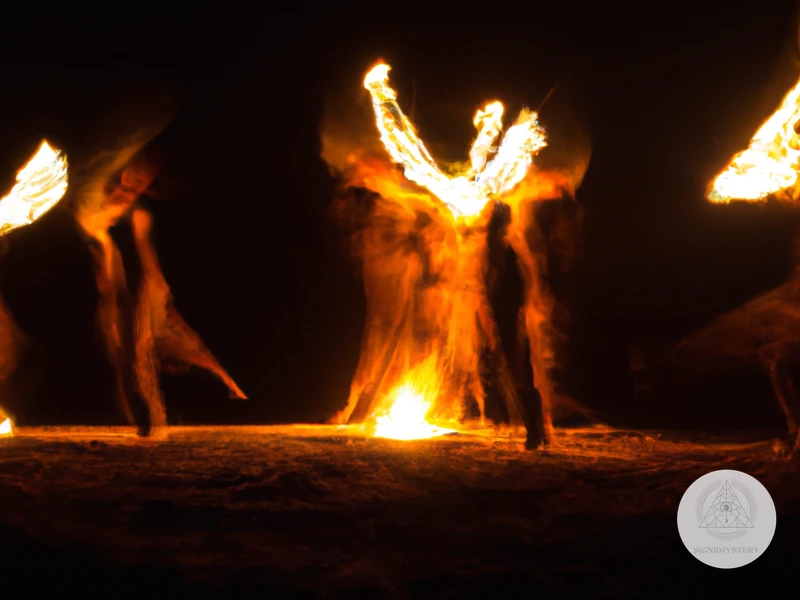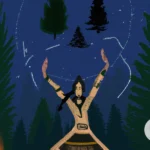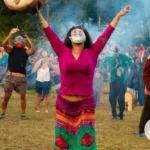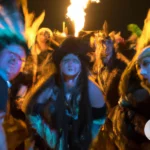The art of movement has been used as a form of spiritual expression and connection for centuries, particularly in shamanic practices. Shamanic dance is a form of movement that allows individuals to reach altered states of consciousness, connect with the spiritual realm, and access inner wisdom. Creating a shamanic dance ritual can be a powerful way to deepen your spiritual practice and connection to the earth. In this article, we will explore what shamanic dance is, the steps to prepare for your ritual, the key elements of shamanic dance, and how to facilitate your own ritual. Join us on this journey of self-discovery and connection to the divine through movement and intention.
What is Shamanic Dance?
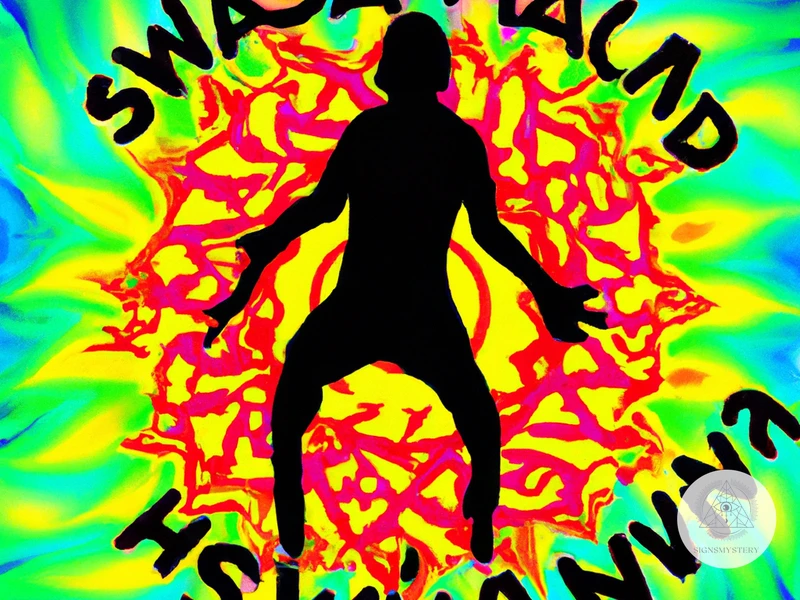
Shamanic dance is a powerful tool for spiritual exploration and healing. It is characterized by its emphasis on the dancer’s connection to the earth and the spirits that inhabit it. Through rhythmic movement, deep breathing, and focused intention, shamanic dancers can enter into altered states of consciousness and access the wisdom and guidance of the unseen realms. Unlike traditional dance, shamanic dance is less concerned with aesthetics and more focused on the ecstatic experience of communing with the divine. If you are looking to incorporate shamanic dance into your spiritual practice, there are many resources available to help guide you on your journey. Some popular styles of ecstatic dance for shamanic practice include trance dance and ecstatic healing dance, both of which offer unique opportunities for self-discovery and transformation.
Understanding Shamanism
Shamanism is a practice that dates back thousands of years and has roots in many different cultures around the world. At its core, shamanism is a practice that connects the practitioner with the spirit world through dance, trance, and other techniques. There are many different forms of shamanism, but they all share the belief that the spirit world is integral to our physical world and that it can be accessed through shamanic practices.
One of the key elements of shamanism is the concept of the journey. During a shamanic journey, the practitioner enters an altered state of consciousness, often through dance or music, and communicates with spirits or other entities. These journeys can be used for healing, divination, or other purposes.
Shamanic dance is a form of ecstatic dance that is used in shamanic practice. It involves moving the body in a way that allows the practitioner to connect with the spirit world and enter a trance state. This type of dance can be used for healing or for communicating with spirits.
To truly understand shamanism, it is important to respect the traditions of the cultures in which it originated. Shamanism is a spiritual practice that is deeply connected to specific cultural beliefs and traditions. It is not a trend or a fad, and should be approached with reverence and humility.
There is much to be gained from exploring the world of shamanism and shamanic dance. By understanding the philosophy and techniques of shamanism, practitioners can connect with the spirit world and gain a deeper understanding of themselves and the world around them.
Further Reading:
- The Role of Ecstatic Dance in Shamanism
- Ecstatic Trance Dance as a Spiritual Journey
- Dance as a Form of Shamanic Healing
- Ecstatic Dance to Connect with the Spirit World
Ecstatic Dance vs. Traditional Dance
When it comes to dance practices, there are two main categories: traditional dance and ecstatic dance. While traditional dance typically follows specific choreography or moves, ecstatic dance allows for spontaneous, free-form movement. Here are some key differences between the two:
| Traditional Dance | Ecstatic Dance |
|---|---|
| Pre-determined steps or choreography | Free form, spontaneous movement |
| Often performed to specific music genres or styles | Open to any type of music |
| Cultural or historical significance | Less emphasis on cultural or historical significance, more on personal expression |
While traditional dance can help preserve cultural practices and tell stories through movement, ecstatic dance allows individuals to tap into their own inner rhythms and express themselves freely. In shamanic practice, ecstatic dance can be particularly powerful in facilitating journeying and connecting with spirits, as it allows for a deeper connection with the self and the present moment.
Preparing for Your Ritual
Preparing for a shamanic dance ritual requires careful planning and intention-setting. First, set intentions for the ritual, such as healing, release, or connection with spirits. Next, choose music that reflects the intention and carries the participants on a journey. Consider selecting a space that promotes safety, privacy, and natural elements. Make sure to gather tools, such as objects to call the directions, instruments, and offerings for spirits. Finally, create a clear plan and timeline for the ritual to flow smoothly and safely. By taking these steps, you will be prepared to create a transformative and powerful shamanic dance ritual.
Setting Intentions
Setting intentions is a vital part of creating an ecstatic dance ritual for shamanic practice. It involves becoming clear on the purpose of the ritual and what you hope to achieve through it. Here are some steps to help you set powerful intentions:
| 1. | Quiet your mind: Find a quiet space where you can sit and reflect. Take a few deep breaths, close your eyes and bring your attention to your breath. Slowly, exhale all the air from your lungs and inhale, visualizing bright light and energy entering your body with your breath. Sit in this calm and soothing space until your mind is calm and clear. |
| 2. | Clarify your intention: Think about what you hope to achieve through your ritual. What do you want to release, transform, or invite into your life? Write it down on a piece of paper or in your journal. |
| 3. | Make it personal: Your intention should be grounded in your personal experience. Identify how you want to feel after the ritual and imagine what that would look like in your life. For example, if you’re seeking healing, imagine yourself free from the pain or physical condition that’s bothering you. |
| 4. | Use affirmative language: Write your intention in positive language, as if it has already happened and you’re experiencing its benefits. |
| 5. | Amplify your intention: Use visualization, affirmation, meditation or any other tool that resonates with you to amplify the energy of your intention. Imagine a bright light around your intention and see it manifesting fully in your life. |
By following these steps, you can set clear and powerful intentions for your shamanic dance ritual. Remember, your intentions are the foundation of the ritual, so take the time to make them meaningful and personal.
Choosing Your Music
When it comes to choosing your music for your shamanic dance ritual, there are certain considerations you should keep in mind. The right music can help guide participants into a deeper state of consciousness and can enhance the overall experience. Here are some tips for choosing your music:
| Consideration | Explanation |
|---|---|
| Intention | Consider the intention of your ritual and choose music that supports that intention. If you are seeking healing, for example, you may want to choose music that is soothing and calming. If you are looking to connect with spirit guides, you may want to choose music with a more mystical or otherworldly feel. |
| Rhythm | The right rhythmic structure can be crucial for helping participants enter a trance-like state. Consider using music with a steady, driving beat or one with a slow, steady pulse. |
| Instrumentation | The instruments used in the music can have a profound effect on the overall experience. Consider using music with traditional shamanic instruments like drums, rattles, and flutes. |
| Energy | Consider the overall energy of the music you choose. If you are looking to build intensity and energy, you may want to choose more upbeat or energetic music. If you are looking to create a more introspective and reflective atmosphere, you may want to choose music that is slower and more meditative. |
| Length | Consider the length of your ritual and choose music that fits that time frame. You don’t want to choose music that is too short and leaves participants feeling rushed or too long, leaving them feeling restless or drained. |
Keep in mind that while the right music can be helpful, it is not the only factor in creating a successful shamanic dance ritual. It’s important to also focus on creating a safe and supportive space, setting clear intentions, and guiding participants through the various elements of the experience. With the right preparation and attention to detail, you can create a powerful and transformative shamanic dance ritual for yourself and others.
Selecting Your Space
When selecting the space for your shamanic dance ritual, it’s important to consider the atmosphere, energy, and accessibility. Look for a space that feels safe, comfortable, and spacious enough to move freely. Ideally, the location should be private, quiet, and free of distractions.
Indoor Space: If you’re hosting your ritual indoors, a clear and uncluttered room is ideal. Look for a space that can accommodate the number of participants you expect, leaving enough room for everyone to move comfortably. Consider the lighting and temperature of the space as well. A dimly lit room can help create a more mystical atmosphere, while proper air conditioning or heating is crucial to keeping everyone comfortable and focused.
Outdoor Space: If you’re hosting your ritual outdoors, nature provides the perfect backdrop for your shamanic practice. Look for a secluded area where you won’t be disturbed by passersby. Consider the time of day and the weather conditions. If it’s too hot or too cold, it can be distracting and uncomfortable for participants. Make sure to provide shade for hot days and have a backup plan in case of inclement weather.
Sacred Spaces: Sacred spaces such as spiritual centers, temples, or other places of worship can also be used for shamanic dance rituals. If you choose to use a sacred space, make sure to respect the customs and traditions of the space. Seek permission from the appropriate authorities and follow any guidelines they may have.
Cleansing the Space: Once you’ve selected your space, it’s important to cleanse it. Use white sage or Palo Santo to clear any negative energy and create a sacred space for your ritual. You may also want to set up an altar with meaningful objects, stones, or crystals to enhance the energetic space.
By selecting the right space for your shamanic dance ritual, you can create an atmosphere that supports and enhances your practice, allowing you to fully connect with yourself and the spirits.
Gathering Your Tools
When it comes to creating an ecstatic dance ritual for shamanic practice, it’s important to have the right tools on hand. These tools can help you feel more connected to the elements and spirits around you, and might include items such as crystals, plants, or instruments like drums or rattles.
Crystals: Some shamans believe that crystals can help amplify energy and intention during a dance ritual. Choosing crystals for your practice might involve selecting ones with properties that align with your specific intentions, such as clear quartz for clarity or rose quartz for love and compassion.
Plants: Depending on your tradition, you may also want to gather plants to use in your ritual. This might include smudging herbs like sage or palo santo to clear the space and participants before the dance, or incorporating other plants that hold special significance for you.
Instruments: Many shamanic dance rituals involve the use of drums or rattles to create a specific rhythm that helps guide the movement of the participants. If you plan to use instruments in your practice, make sure to have them readily available and in good working order. You might also consider having extra instruments on hand in case others join your dance and wish to participate.
In addition to these physical tools, you might also want to gather items that help create a sense of ceremony and focus. This might include candles, incense, or a special altar where you can arrange your tools and other sacred objects. By thoughtfully gathering your tools and spending time preparing your space, you can create a more meaningful and intentional dance ritual that honours your spiritual path.
The Elements of Shamanic Dance
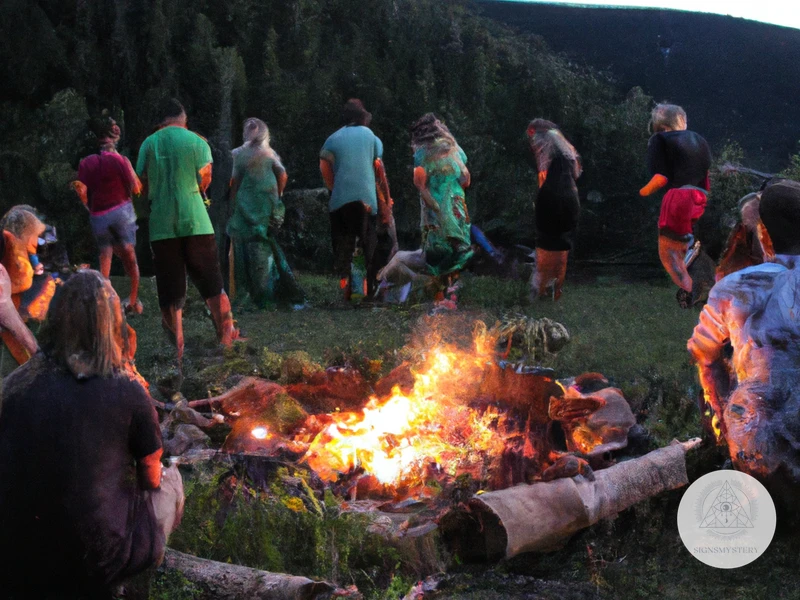
In shamanic dance, there are several key elements that work together to create a powerful and transformative experience. Calling the directions, or orienting oneself within the physical space by acknowledging the cardinal directions and the energies associated with them, is a fundamental aspect of shamanic practice. Connecting with spirits is also crucial, as the dance is seen as a means of communing with the divine and the natural world. The dance itself involves journeying with movement, using the body as a tool for exploration and expression. Finally, the process of grounding and integration helps ensure that the experience is not only transcendent but also meaningful and applicable to everyday life. By incorporating these elements into one’s shamanic dance practice, it is possible to unlock powerful insights and healing energies.
Calling the Directions
Calling the directions is an essential element of shamanic dance ritual. It involves the act of invoking, connecting, and aligning with the four cardinal points of the earth and the spiritual entities associated with them. The purpose of calling the directions is to create a sacred space, offer respect, and seek guidance from the spirits residing in each direction.
To call the directions, find a space where you can face each cardinal point. It’s ideal to start in the east, facing the direction of the rising sun. Give thanks to the energy of the east, the element of air, and the spirit of the eagle. Bow your head and say, “Hail to the east, the place of the rising sun, the element of air, and the spirit of the eagle. We honor and welcome you into this sacred space.”
Turn to the south, where the sun reaches its highest point. Acknowledge the energy of the south, the element of fire, and the spirit of the serpent. Bow your head and say, “Hail to the south, the place of the midday sun, the element of fire, and the spirit of the serpent. We honor and welcome you into this sacred space.”
Next, turn to the west, where the sun sets. Give thanks to the energy of the west, the element of water, and the spirit of the bear. Bow your head and say, “Hail to the west, the place of the setting sun, the element of water, and the spirit of the bear. We honor and welcome you into this sacred space.”
Finally, face the north, where the sun is hidden and the earth is still. Acknowledge the energy of the north, the element of earth, and the spirit of the buffalo. Bow your head and say, “Hail to the north, the place of darkness and the earth’s stillness, the element of earth, and the spirit of the buffalo. We honor and welcome you into this sacred space.”
After calling the directions, it’s important to hand over your intentions, prayers, and offerings to the spirits residing in each cardinal point. Offer gratitude for their presence, guidance, and protection throughout the shamanic dance ritual.
Connecting with Spirits
Connecting with Spirits is an important aspect of Shamanic Dance as it helps participants enter a trance state and connect with spiritual entities. Before beginning the dance, it is important to create a sacred space and set up an altar with objects that represent the spirits you wish to connect with.
Drumming or rattling is commonly used to facilitate the connection with spirits. The repetitive sound can help induce a trance-like state and allow participants to access altered states of consciousness. As you dance, focus on your intention and allow yourself to be open to receiving messages from spirits.
Visualizations can also be used to facilitate the connection with spirits. You can visualize yourself surrounded by a protective circle of light or imagine yourself standing at the entrance to a sacred cave, waiting to receive guidance from your spirit guides.
It is important to trust your intuition and allow yourself to be guided by your spirits during the dance. If you feel drawn to a certain movement or direction, follow it. If you receive a message or vision, take note of it and bring it back with you to integrate into your daily life.
At the end of the dance, take time to thank the spirits for their guidance and support. You can also leave offerings such as herbs, flowers, or crystals on your altar as a symbol of gratitude.
Connecting with spirits is a powerful aspect of Shamanic Dance that can provide guidance and insight into our lives. By allowing ourselves to be open and receptive to spiritual messages, we can deepen our connection to the divine and live more fulfilling lives.
Journeying with Movement
Journeying with movement is the heart of shamanic dance. It involves using movement to connect with the spirit world and to journey within oneself. This is a powerful technique that can be used to gain insight and healing.
There are several ways to journey with movement during a shamanic dance ritual. Some popular methods include:
| Technique | Description |
|---|---|
| Trance Dance | This involves dancing with a blindfold or in a darkened room. The lack of visual stimuli allows dancers to enter a trance-like state and journey within. |
| Free Movement | This involves allowing the body to move freely and spontaneously. Dancers follow their intuition and allow their bodies to express whatever needs to be expressed. |
| Ritual Movement | This involves using specific movements or gestures that have meaning in shamanic tradition. For example, moving like an animal or making specific hand gestures to symbolize connection with spirits. |
No matter what technique is used, journeying with movement should be done with intention and focus. Dancers should set a clear intention before beginning the dance, such as asking
Subscribe to Our Newsletter
Sign up to receive the latest news and updates.
During the dance, dancers may experience a wide range of emotions and physical sensations. This can include feelings of ecstasy, connection to the divine, and a sense of release. It’s important to allow these experiences to happen without judgment or analysis.
When the dance is complete, it’s helpful to take some time for integration. This can involve sitting quietly, journaling, or sharing with others in the group. It’s also important to stay grounded and to continue to breathe deeply as the experience is integrated into daily life.
Journeying with movement is a powerful tool for shamanic practice. It allows us to connect with the divine within ourselves and to gain insight and healing. By approaching the dance with intention, focus, and openness, we can create a profound and transformative experience.
Grounding and Integration
The final stage of your shamanic dance ritual is the grounding and integration phase. This is a crucial component to ensure that your participants leave the dance feeling balanced and centered. After the intense movement and journeying, the grounding process helps to root the energy back into the earth and the physical body.
To begin, you can have your participants find a comfortable and quiet spot in the space to sit or lie down. Encourage them to focus on their breath and to take deep, slow inhales through the nose and exhales through the mouth. This will help them to connect with their physical body and to release any remaining tension.
Next, guide your participants through a visualization exercise focused on grounding. Ask them to imagine a strong and sturdy tree with deep roots growing from the soles of their feet. Instruct them to visualize the roots extending deep into the earth, anchoring them firmly and supporting their body. Tell them to envision drawing up the earth’s energy through their roots and into their body with each inhale, and to release any stagnant energy on each exhale.
After the visualization exercise, give your participants a few minutes to rest and integrate their experience. Provide them with a journal or a piece of paper to write down any insights or realizations they may have had during the ritual.
Finally, offer an opportunity for the group to come together and share their experiences or insights. This will allow for a deeper integration and connection among the participants.
Remember, grounding and integration are essential for the overall success of your shamanic dance ritual. By providing a supportive and safe space for your participants to release and integrate, you will help them to feel more connected to themselves, each other, and the world around them.
Facilitating Your Ritual
Facilitating your ritual is a crucial part of creating a successful ecstatic dance experience. As a facilitator, your role is to guide participants through the journey while holding space for their experiences. One effective way to do this is to incorporate the use of Ritual Tools such as sage, crystals, and feathers. These tools can help to clear the energy in the space and create a sacred atmosphere. Another important aspect of facilitating is to Lead Your Participants through the different stages of the dance, starting with setting intentions, calling the directions, journeying with movement, and ending with grounding and integration. It’s also important to Closing the Ritual in a respectful and gentle way, allowing participants to slowly come back to their awareness and share any insights or experiences they had during the dance. By facilitating the ritual with intention, presence, and reverence, you can create a powerful and transformative experience for yourself and others.
Leading Your Participants
Leading your participants is an essential part of facilitating a shamanic dance ritual. As a guide, you are responsible for creating a safe and welcoming environment that allows everyone to connect deeply with their inner selves. Here are some tips on how to lead your participants for a successful shamanic dance ritual.
1. Start with a Warm-Up: Begin your ritual with an opening circle or a brief meditation to center your participants. Encourage them to stretch and move their bodies to the music.
2. Give Clear Instructions: Before beginning your ritual, provide clear instructions on how participants should move their bodies. Encourage them to let go of self-judgment and move as they feel called to while honoring the boundaries of others.
3. Model the Movement: Show your participants how to move their bodies by modeling it yourself. This can help break the ice and inspire your participants to let loose and move freely.
4. Encourage Authentic Expression: Let your participants know that their unique expressions are welcome and encouraged. Encourage them to breathe deeply and move the way their body wants to.
5. Offer Support: Keep an eye on your participants and observe if anyone looks like they need extra support or guidance. Offer gentle suggestions to guide their movements or provide physical support if necessary.
6. Facilitate Connection: Encourage participants to connect with one another during the dance by inviting them to hold hands or move together in a circle. This can help create a sense of unity and community among participants.
7. Provide Closure: After the dance, bring your participants back together in a closing circle. Offer a brief meditation or gratitude practice to honor the experience and gently transition back to everyday life.
By leading your participants in a mindful and supportive way, you can help create a powerful and transformational shamanic dance ritual.
Closing the Ritual
Closing the ritual is just as important as opening it. It marks the end of the journey and brings closure to the experience your participants have just undergone. To effectively close the ritual, start by calling back any spirits or energies that were invoked at the beginning. Use intention and your energy to say goodbye and thank the spirits for their guidance and protection throughout the ritual.
Next, gather your participants in a circle once again and lead them in a final movement practice. Encourage them to move in a way that feels good to them, and to release any remaining tension or emotion that may have surfaced during the ritual. Use soft and gentle music to bring the energy of the ritual back down to a more grounded state.
After your final movement practice, take a few moments to allow your participants to reflect on their experience. You can ask if anyone wants to share their thoughts or feelings, but respect those who choose to remain silent. Once everyone has had a chance to reflect, use gratitude to thank your participants for showing up and sharing in this experience with you.
Finally, end the ritual with a simple closing statement or prayer. This can be something as simple as “May we carry the gifts of this ritual with us as we continue on our journey,” or you can recite a traditional shamanic prayer if that feels more appropriate. With the closing statement, bring your hands together in a prayer position to show respect and gratitude.
Remember, closing the ritual is just as important as opening it. It helps to bring closure to the experience and allows your participants to leave feeling grounded and centered. Use intention and energy to bring the ritual to a close, and always show gratitude to the spirits, your participants, and yourself for the work that was done.
Sharing and Integration
Sharing and integration is a crucial part of any shamanic dance ritual. It is a time for participants to share their experiences and emotions with the group and to integrate any insights or lessons they may have gained during the ritual.
During the sharing and integration portion of the ritual, it is important to create a safe and supportive environment where everyone feels comfortable speaking their truth. Here are some tips to facilitate this process:
- Set clear guidelines: Before beginning the ritual, establish guidelines for sharing that promote active listening, non-judgment, and confidentiality. Let participants know that they are free to share as much or as little as they feel comfortable with and that no one is required to speak if they don’t want to.
- Encourage empathy: Encourage participants to listen with empathy, putting themselves in the speaker’s shoes and understanding their experience from their point of view.
- Provide prompts: To facilitate sharing, provide participants with prompts that encourage them to reflect on their experience. For example, you might ask, “What did you learn during the ritual?” or “How did you feel during the ritual?”
- Use a talking stick: If you have a large group, consider using a talking stick to ensure that everyone has a chance to speak. The person holding the stick is the only one allowed to speak, while everyone else listens attentively.
Sharing and integration can be an emotional and vulnerable process, so be sure to end the ritual on a positive note. Thank everyone for their participation and encourage them to take the lessons they learned during the ritual into their daily lives. By creating a supportive and safe space for sharing and integration, you can help participants deepen their connection to themselves, to each other, and to the earth.
Conclusion
In conclusion, creating an ecstatic dance ritual for shamanic practice can be a powerful tool for personal transformation and healing. By combining the ancient wisdom of shamanism with the expressive freedom of dance, you can create a safe and sacred space for yourself and others to explore the depths of their being. Remember, intention is key when embarking on any spiritual practice, so be sure to set clear and focused intentions for your ritual.
Choosing the right music and space is also important to create the right atmosphere for your ritual. The music you choose can help to guide the journey and evoke different emotions and energies, so take the time to carefully curate a playlist that resonates with you and your intentions. And don’t forget about the physical space you choose – it should feel safe, spacious, and conducive to movement and expression.
As you move through the various elements of the ritual – calling in the directions, connecting with spirits, journeying with movement, grounding and integration – allow yourself to fully surrender to the experience. This is a time to let go of any judgments or expectations and trust the wisdom of your body and spirit.
Facilitating a group ritual can also be a powerful way to deepen your practice and connect with others. As the leader, it’s important to create a container of safety and trust and guide the group through the various elements of the ritual. Remember to encourage participants to share their experiences and insights, as this can deepen the integration process.
Overall, creating an ecstatic dance ritual for shamanic practice is a beautiful and transformative way to connect with your inner self, express your emotions and connect with the spiritual realms. Whether you’re dancing alone or facilitating a group ritual, remember to approach the experience with curiosity, openness and love.
Frequently Asked Questions
What is the purpose of a shamanic dance ritual?
The purpose of a shamanic dance ritual is to connect with spirits, go on inner journeys, and receive guidance and healing through movement and intention.
Do I need to have experience in shamanic practice to participate in a shamanic dance ritual?
No, prior experience in shamanic practice is not necessary, but it’s important to have an open mind and respect for the practice.
What should I wear to a shamanic dance ritual?
Wear comfortable, loose-fitting clothing that allows you to move freely. Many people prefer to dance barefoot or wear soft-soled shoes.
Is it necessary to use specific types of music for shamanic dance?
No, the type of music you use is up to your personal preference. However, it’s recommended to select music that is uplifting, rhythmic, and has a meditative quality.
How long should a shamanic dance ritual last?
A typical shamanic dance ritual can last anywhere from 60-90 minutes, but the length can vary depending on the group’s needs and preferences.
Can a shamanic dance ritual be done alone?
Yes, a shamanic dance ritual can be done alone, but it’s recommended to have a trained practitioner guide you through the experience.
What kind of space is best for a shamanic dance ritual?
An ideal space for a shamanic dance ritual is quiet, secluded, and has enough room for free movement. It’s also important to have good ventilation and natural light if possible.
What kind of intention should I set for a shamanic dance ritual?
Your intention should be specific, focused, and align with your personal goals and needs. For example, your intention might be to connect with your higher self, receive guidance, or release emotional blockages.
Should I incorporate any specific tools or props into my shamanic dance ritual?
While not necessary, some people choose to incorporate props like rattles, drums, or incense into their shamanic dance ritual to enhance the experience.
Is there a specific way to close a shamanic dance ritual?
While there is no one right way to close a shamanic dance ritual, it’s important to take time to ground yourself and express gratitude to the spirits and the participants for their energy and presence.

